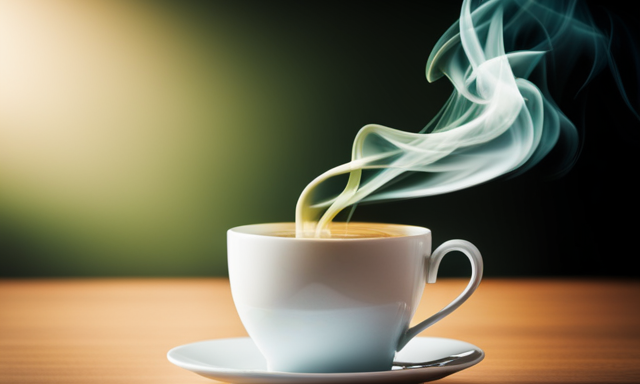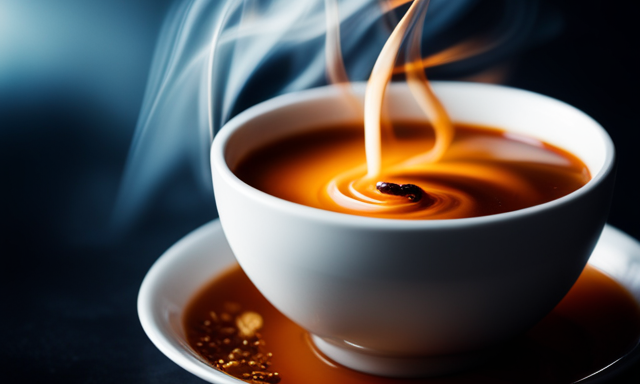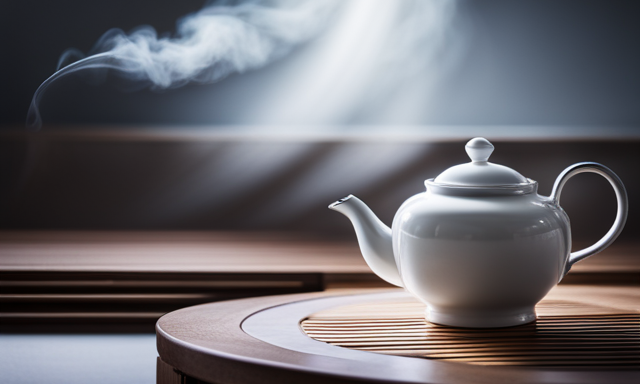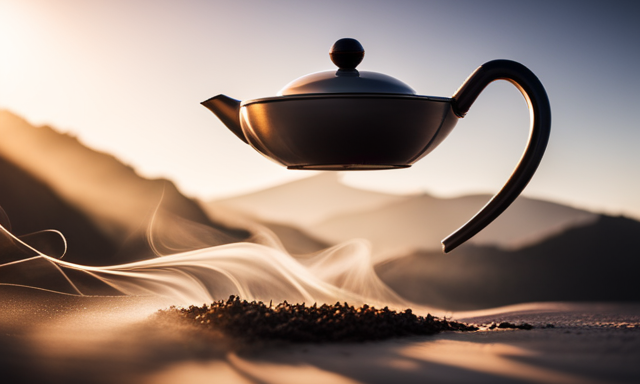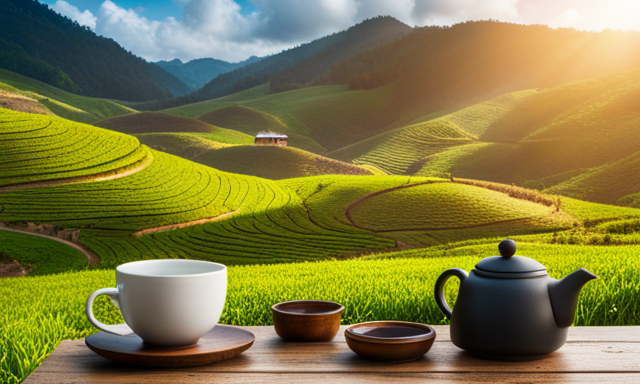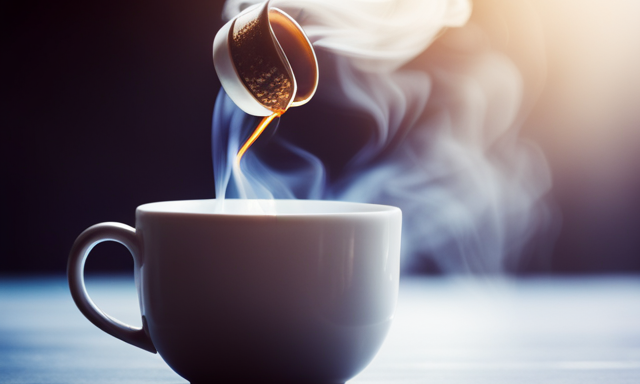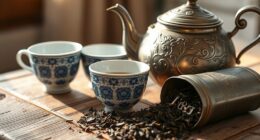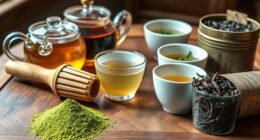When it comes to tea, there’s a whole world of flavors and benefits to explore. One particular tea that has caught my attention is oolong tea. This unique brew is like a delicate dance between green and black tea, offering a taste and experience that is truly one-of-a-kind.
Known for its partial fermentation process, oolong tea strikes a perfect balance between the lightness of green tea and the robustness of black tea. But oolong tea is not just about its flavor; it also boasts a range of health benefits.
From aiding in weight loss to promoting digestive health and enhancing mental well-being, oolong tea is a true powerhouse.
In this article, we will delve into the origins and history of oolong tea, explore its wide range of flavors, discuss brewing techniques, and uncover its many health benefits.
So grab a cup of oolong tea, sit back, and let’s embark on a journey to discover what makes this tea so special.
Key Takeaways
- Oolong tea is noted for its benefits in aiding digestion and reducing inflammation.
- It is known to promote mental well-being, reduce anxiety, and improve cognitive function.
- Oolong tea has unique flavors and varying caffeine levels, making it a versatile choice.
- Popular varieties of oolong tea include Tie Guan Yin, Da Hong Pao, Oriental Beauty, and Jin Xuan, each with its own distinct flavor and aroma.
Origins and History of Oolong Tea
You’re going to love learning about the fascinating origins and rich history of oolong tea! Oolong tea has its roots in China, where it has been enjoyed for centuries.
The origins of oolong tea can be traced back to the Fujian province, known for its lush tea gardens and skilled tea artisans. This region’s unique climate and soil conditions contribute to the distinctive flavor and aroma of oolong tea.
Beyond its delicious taste, oolong tea holds cultural significance in Chinese traditions and ceremonies. It is often served during important events and celebrations, symbolizing harmony and respect.
One of the most intriguing aspects of oolong tea is its partial fermentation process, which sets it apart from other teas. This process, which I will delve into in the next section, gives oolong tea its unique flavor profile.
Partial Fermentation Process
Indulge in the unique experience of savoring a beverage that undergoes a fascinating partial fermentation process, resulting in a flavor profile that dances on your taste buds. Oolong tea is known for its distinct production method, which involves a careful balance of oxidation and withering.
During the fermentation process, the tea leaves are partially oxidized, giving them a complex and nuanced flavor. Here are three ways this process contributes to the tea’s exceptional taste:
-
The partial fermentation process allows the tea leaves to develop a delightful floral aroma, reminiscent of blooming gardens.
-
It imparts a smooth and mellow taste, with notes of honey and fruits that play harmoniously on your palate.
-
The fermentation process also gives oolong tea a unique depth of flavor, with hints of roasted nuts and a lingering, sweet aftertaste.
As we explore the health benefits of oolong tea, you will discover how this intricate fermentation process enhances its therapeutic properties.
Health Benefits of Oolong Tea
Immerse yourself in the world of wellness and discover the myriad health benefits that come with savoring a cup of this enchanting brew. Oolong tea isn’t just a delicious beverage, but it also offers a range of health benefits.
One notable benefit is its ability to enhance mental clarity. The combination of caffeine and theanine in oolong tea promotes alertness and focus, making it the perfect companion for a productive day.
Additionally, oolong tea contains anti-inflammatory properties, which can help reduce inflammation in the body and alleviate symptoms of certain conditions. These health benefits make oolong tea a fantastic choice for those seeking a natural way to boost their well-being.
Transitioning into the next section, oolong tea also offers a wide range of flavors to please any palate.
Wide Range of Flavors
Get ready to embark on a taste adventure as you explore the wide array of flavors that oolong tea has to offer, like a journey through a kaleidoscope of delightful sensations. Oolong tea is known for its diverse flavor profiles, ranging from delicate and floral to rich and robust. The flavors can vary depending on factors such as the region where the tea is grown, the processing methods used, and the specific tea leaves used in the blend. To fully appreciate the nuances of oolong tea, tea tasting techniques can be employed. By using a three-column, three-row table, you can record your observations on the aroma, taste, and aftertaste of different oolong teas, noting the subtle variations in each cup. As you explore the flavors of oolong tea, you’ll soon discover your personal preferences and be able to brew the perfect cup that suits your taste. Now, let’s delve into the art of brewing techniques for oolong tea.
Brewing Techniques for Oolong Tea
To fully appreciate the intricacies of brewing oolong tea, one must master the art of water temperature control and steeping times. Oolong tea is known for its delicate flavors that can be easily ruined if not brewed properly.
The brewing temperature for oolong tea is crucial, as it can range from 180°F to 205°F (82°C to 96°C), depending on the type of oolong and personal preference. Steeping time is equally important, as it determines the strength and taste of the tea. Generally, oolong tea is steeped for 2 to 5 minutes, but some varieties may require shorter or longer steeping times.
Achieving the perfect balance of temperature and steeping time will unlock the true potential of oolong tea, allowing you to savor its unique flavors and aromas.
Transitioning into the next section, oolong tea also serves as a wonderful alternative to coffee, offering a rich and satisfying beverage option.
Oolong Tea as a Coffee Alternative
Indulging in a cup of oolong tea, with its robust and satisfying flavors, is like wrapping yourself in a warm, comforting blanket of caffeine-free energy. Oolong tea, known for its unique flavor profile, can also serve as a wonderful coffee alternative.
Here are some reasons why oolong tea can be a great choice for those seeking an alternative to coffee:
- Oolong tea contains less caffeine compared to coffee, making it a gentler option for those sensitive to caffeine.
- Despite its lower caffeine content, oolong tea still provides a natural energy boost, helping you stay alert and focused throughout the day.
- Oolong tea is rich in antioxidants, such as polyphenols, which have been linked to various health benefits, including improved heart health and reduced inflammation.
Transitioning into the next section about oolong tea and weight loss, it’s fascinating to explore how this incredible beverage can potentially aid in shedding those extra pounds.
Oolong Tea and Weight Loss
Lose weight effectively by incorporating the weight loss benefits of oolong tea into your daily routine. Oolong tea has been known to boost metabolism, making it easier for your body to burn calories and shed those extra pounds.
The polyphenols found in oolong tea have been shown to activate enzymes that enhance fat oxidation and increase energy expenditure. Additionally, oolong tea can help regulate blood sugar levels, preventing spikes and crashes that can lead to overeating and weight gain.
By stabilizing blood sugar, oolong tea can also curb cravings and promote feelings of fullness, making it easier to stick to a healthy diet.
As we transition into discussing oolong tea’s impact on digestive health, it is important to note that weight loss is just one of the many benefits this versatile tea has to offer.
Oolong Tea and Digestive Health
Boost your digestive health with a cup of oolong tea, which has been found to improve bowel regularity and reduce the risk of constipation by promoting healthy gut bacteria. Did you know that a study found that regular consumption of oolong tea can increase the frequency of bowel movements by up to 30%?
Here are four digestive benefits of oolong tea:
-
Reduces bloating: Oolong tea contains compounds that help soothe the digestive system, reducing bloating and discomfort.
-
Supports nutrient absorption: The polyphenols in oolong tea can enhance the absorption of nutrients in the gut, ensuring your body gets the most out of the food you eat.
-
Eases digestion: Oolong tea stimulates the production of digestive enzymes, aiding in the breakdown of food and facilitating smoother digestion.
-
Calms inflammation: The antioxidants found in oolong tea have anti-inflammatory properties, which can help reduce inflammation in the gut and alleviate digestive issues.
With its numerous digestive benefits, oolong tea isn’t just a delicious beverage but also a great ally for maintaining a healthy gut.
Transitioning into the next section, let’s explore how oolong tea can also contribute to our mental well-being.
Oolong Tea and Mental Well-being
Improve your mental well-being by embracing the calming effects of a warm cup of oolong tea. Oolong tea is known for its ability to provide stress relief and promote relaxation. The natural compounds found in oolong tea help to reduce anxiety and improve overall cognitive function.
To understand the benefits of oolong tea on mental well-being, let’s take a look at the following table:
| Oolong Tea and Stress Relief | Oolong Tea and Cognitive Function |
|---|---|
| Reduces anxiety | Enhances focus and concentration |
| Promotes relaxation | Improves memory retention |
| Calms the mind | Boosts mental alertness |
| Relieves tension | Supports brain health |
By incorporating oolong tea into your daily routine, you can experience the soothing effects it has on your mind and body. As we delve further into choosing and storing oolong tea, you’ll discover additional ways to enhance your tea-drinking experience.
Choosing and Storing Oolong Tea
When it comes to choosing oolong tea, there are different varieties available, each with its own unique characteristics. From floral and fruity to toasty and nutty, the flavor profiles of oolong tea can vary widely. It’s important to consider your personal taste preferences and desired aroma when selecting the right oolong tea for you.
Additionally, proper storage techniques are crucial in preserving the flavor and freshness of oolong tea. To maintain its delicate flavors, it’s best to store oolong tea in an airtight container, away from light, heat, and moisture. This will help ensure that every cup of oolong tea you brew is as flavorful and enjoyable as possible.
Different varieties and their characteristics
One notable characteristic of oolong tea is its diverse range of varieties and their unique characteristics. Oolong tea is known for its intricate processing, which involves partial oxidation and a careful balance between oxidation and fermentation. This results in a tea that falls between green and black tea in terms of flavor and aroma. The caffeine levels in oolong tea also vary depending on the variety, with some having higher levels than others. To give you a glimpse of the different varieties, here is a table showcasing four popular types of oolong tea and their characteristics:
| Variety | Flavor Profile | Aroma |
|---|---|---|
| Tie Guan Yin | Floral, creamy | Orchid, honey |
| Da Hong Pao | Robust, smoky | Roasted nuts, wood |
| Oriental Beauty | Fruity, honeyed | Peach, honey |
| Jin Xuan | Creamy, buttery | Light floral notes |
Now that you know about the different varieties of oolong tea, let’s explore proper storage techniques to preserve their flavor and freshness.
Proper storage techniques to preserve flavor and freshness
To maintain the exquisite flavors and freshness of oolong tea, it’s essential to employ proper storage techniques. Properly storing oolong tea is crucial in preserving its unique flavors and ensuring its longevity.
Firstly, it is important to store oolong tea in an airtight container to prevent exposure to oxygen, which can degrade the tea’s flavor and aroma. Additionally, the container should be kept in a cool and dark place, away from direct sunlight and heat sources, as these can accelerate the tea’s deterioration.
Avoid storing oolong tea near strong-smelling substances, as tea leaves are highly absorbent and can easily pick up odors.
Lastly, it’s recommended to consume oolong tea within a reasonable time frame to enjoy its optimal flavor and freshness.
By following these proper storage techniques, you can savor the delightful taste of oolong tea for an extended period.
Frequently Asked Questions
Can oolong tea be consumed by pregnant women?
Oolong tea should be consumed in moderation during pregnancy. It contains caffeine, which may affect fetal development. However, it can be enjoyed in limited amounts for its potential benefits on fertility and overall health.
Does oolong tea contain caffeine?
Yes, oolong tea does contain caffeine. However, it is also known for its weight loss benefits and its ability to improve skin health. Let’s explore how oolong tea can help you achieve your health goals.
What is the ideal water temperature for brewing oolong tea?
The ideal water temperature for brewing oolong tea is around 180-190°F. This ensures a balance between extracting the delicate flavors and avoiding bitterness. Oolong tea offers numerous benefits, such as improving digestion and boosting metabolism.
How long should oolong tea be steeped for optimal flavor?
To achieve optimal flavor, steep oolong tea for 2-3 minutes. Steeping it for too long can result in a bitter taste. Try these tips and tricks for steeping oolong tea and enjoy the weight loss benefits it offers.
Are there any side effects or potential risks associated with drinking oolong tea?
There are minimal side effects and health risks associated with drinking oolong tea. However, it may cause caffeine-related issues such as insomnia or increased heart rate, and some individuals may have allergic reactions.
Conclusion
In conclusion, oolong tea is truly a remarkable beverage with a rich history and a plethora of health benefits. It’s noted for its unique partial fermentation process, which gives it a distinct flavor profile that ranges from floral to fruity. Whether you’re looking to shed a few pounds, improve your digestive health, or simply enhance your mental well-being, oolong tea is a fantastic choice. So why not indulge in a cup of this extraordinary tea and experience its wonders for yourself? After all, who can’t resist the allure of a beverage that combines taste and wellness in one delightful package?

